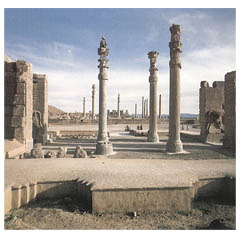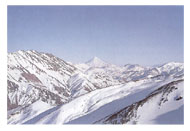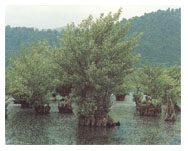 Iran at a Glance Iran at a Glance
Once a great empire, Iran has been traditionally known to the world as Persia. Archeological findings have placed knowledge of Iranian prehistory at middle Paleolithic times (100,000 years ago). Iran was a major transit route on the famous trade Silk Road. Despite millennia of historical upheavals and foreign invaders, Iran has maintained its national and cultural identity as one of the seats of civilization. In 1979, the monarchy regime was toppled down in the revolutionary movement and the nation chose an Islamic republic system of government at a referendum.
-
Iran Map
-
Iran Stone Map
- Iran General Information:
Government type: Islamic Republic of Iran
Capital: Tehran
Administrative divisions:
28 provinces (ostanha, singular—ostan); Ardabil, Azarbayjan-e Gharbi, Azarbayjan-e Sharqi, Bushehr, Chahar Mahall va Bakhtiari, Esfahan, Fars, Gilan,Golestan,Hamadan, Hormozgan, Ilam, Kerman, Kermanshahan, Khorasan, Khuzestan,Kohkiluyeh va Buyer Ahmadi, Kordestan, Lorestan, Markazi, Mazandaran, Qazvin, Qom, Semnan, Sistan va Baluchestan,Tehran, Yazd, Zanjan
Country name:
conventional long form: Islamic Republic of Iran
conventional short form: Iran
local long form: Jomhuri-ye Eslami-ye Iran
local short form: Iran
Location:
Iran is located at the strategic crossroads between the Western and Eastern worlds. It has borders with Armenia, Azerbaijan and Turkmenistan in the north, Afghanistan and Pakistan in the east, and Iraq and Turkey in the west. with Armenia, Azerbaijan and Turkmenistan in the north, Afghanistan and Pakistan in the east, and Iraq and Turkey in the west.
The Caspian Sea lies in the north, the Gulf Oman, the Strait of Hormuz and the Persian Gulf lie in the south of the country. The topography of Iran consists mainly of deserts and mountains. These areas are virtually uninhabitable. Most of the population lives in the northern and north-western areas. Two mountain chains dominate the landscape, the Zagros Mountains and the Elbruz range. Forests and woodlands exist but are rather limited.
Geographic coordinates: 32 00 N, 53 00 E
Climate:Mountainous, with deserts and barren lands in central and east of the country. Iran is  significantly different in terms of temperature, humidity and rainfall from place to place and season to season. The temperature decreases as you travel from south to north. In Tehran, minimum temperature in January may fall to - 4 C and in July rise to +37 C. Spring and Autumn are marked by pleasant climate in most areas of Iran. In general, it can be said that summers are hot and dry and winters harsh and snowy. However, given the climatic diversity, tourists may enjoy winter sports in the mountains while it is possible at the same time to bathe in the warm waters of southern shores. significantly different in terms of temperature, humidity and rainfall from place to place and season to season. The temperature decreases as you travel from south to north. In Tehran, minimum temperature in January may fall to - 4 C and in July rise to +37 C. Spring and Autumn are marked by pleasant climate in most areas of Iran. In general, it can be said that summers are hot and dry and winters harsh and snowy. However, given the climatic diversity, tourists may enjoy winter sports in the mountains while it is possible at the same time to bathe in the warm waters of southern shores.
Seas:
The Persian Gulf in the south, the Caspian Sea in the north. The Caspian Sea is the largest landlocked body of water in the world. There are number of internal lakes, such Orumiyeh -the largest one (4,366 square km) situated in Western Azarbaijan Province.
Major islands in the Persian Gulf are:
Qeshm (1,491 sq. km), Kish (89.7 sq. km) and Lavan (76 sq. km).
Natural resources:
petroleum, natural gas, coal, chromium, copper, iron ore, lead, manganese, zinc, sulfur, stone
Tourism:
For aficionados of nature, history, culture and art, Iran is rich and attractive. Beautiful landscapes plus spellbinding subterranean caves (such as AliSadr), combine with archaeological sites, historical monuments, magnificent ancient cities. Museums rich with artifacts, historic mosques, shrines, mausoleums, fire temples, tombs, bazaars are found across the country. Stone relics, traditional pottery, ceramic, brass work, wood carving, traditional costumes, miniature paintings, murals, carpet and rug shops, teahouses with traditional singing, restaurants with delicious Persian dishes, caviar and king-shrimps, and sport entertainment such as skiing, are all part and parcel of Iran.
Modernity as symbolized by cinema, music concerts and plays provides interesting counterpoint to the ancient and Islamic architecture & art that characterizes Iran.
Isfahan, Mashhad, Shiraz, Tabriz, Tehran, Hamadan, Kerman, Bam, Kermanshah, Yazd, and Caspian Sea, are main tourist centers. Autumn and Spring are the best seasons for travel in Iran. There is a variety of transportation and hotel accommodations for different categories of tourists. Domestic flights, trains, buses, taxis, and private cars-for-hire are available. Major crime is generally not a problem for travelers in Iran.
The traveler must posses a valid passport and proper entry visa. This is a necessity for checking into hotels, boarding flights etc. Incoming and outgoing passengers, are allowed to bring in and take out authorized goods, besides their personal belongings. Travelers are permitted to bring in the country any amount of foreign currencies, if declared and registered in the forms provided at the points of entry. Accordingly, at the time of departure, they may take out the money they declared on their arrival.
Travel to Iran:
Dornagasht, Adventure Travel to Iran
IranTrip, Iranian Travel Agent and Tour Operator
IranParadise, Tour and Travel Agency
International organization participation:
CCC, CP, ECO, ESCAP, FAO, G-19, G-24, G-77, IAEA, IBRD, ICAO, ICC, ICRM, IDA, IDB, IFAD, IFC, IFRCS, IHO, ILO, IMF, IMO, INMARSAT, INTELSAT, IOC, Interpol, IOM (observer), ISO, ITU, NAM, OIC, OPCW, OPEC, PCA, UN, WFTU, UNCTAD, UNESCO, UNHCR, UNIDO, UPU, WCL, WHO, WMO, WTO
|

